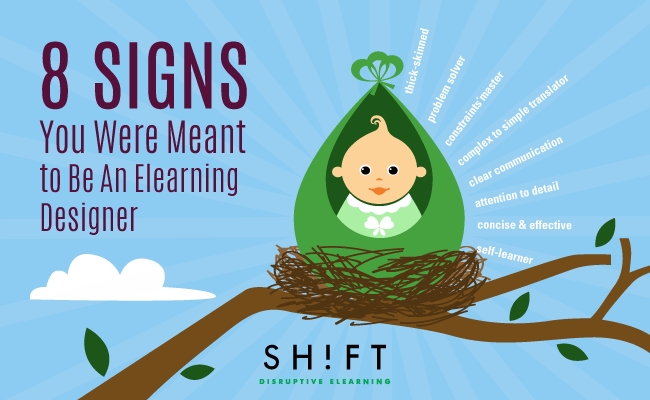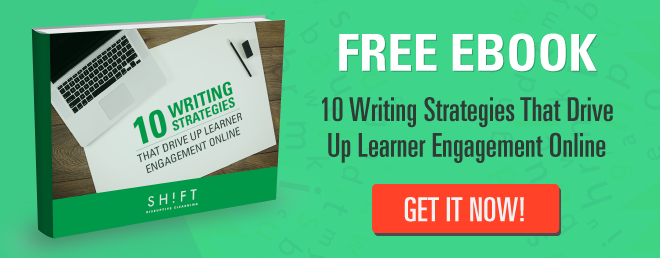Whether you’re an aspiring eLearning designer or a seasoned pro with years of experience, there are some key characteristics that predispose people to succeed at this industry, and we’ve listed them here.

1. You have a little OCD...and that's a good thing!
One person’s definition of OCD is another person’s path to artistic brilliance, also known as attention to detail. While friends and loved ones may deem you a nitpicky perfectionist who focuses on too many little things, you know that you are actually just very good at spotting what needs to be paid attention to.
Non-creative types might note that a design “looks nice” but they don’t know it takes an astute eye to know how to make it look that way, to know what needs to be shifted half an inch one way or the other, to bold, to italicize, etc.
2. You're so thick-skinned, you might be part rhino.
To be a designer you have to be able to take the good, take the bad, take them both and come up with the facts of design or something like that. You will get advice, criticism and suggestions from every angle when you create something and not all of these things will be nice and some things won’t even be helpful. By being thick-skinned and not taking things too personally you will be better able to weed out the constructive criticism from the baseless garbage.
Worried your skin isn’t up to the challenge of criticism? Read some advice on how to live with criticism and get a thick skin here.
3. Constraints lead to creativity and you know it.
Contrary to popular dogma, creativity is not fostered purely by the freedom to do anything you want or the vastness of a blank page. As a eLearning designer you will find that your best ideas come when solving problems that seem to have dozens of constraints. Embracing these restrictions for the opportunities and creative building blocks that they are will set you apart from anyone who looks at them as insurmountable obstacles.
If you’re still not sold on the idea of constraints consider the idea that if you have an unlimited budget and free range to do what you want, wouldn’t it always seem like you’re not doing enough? Wouldn’t it feel harder to even come up with an idea in the first place because you don’t have anything to build upon?
4. Clearly, you're obsessed with clear communication.
If anyone has ever told you to make something “jazzier” or “just a smidge more…more” and you wanted to maybe smack that person for it, then you might be obsessed with clear communication. As a designer you will often find yourself fighting to not only communicate your ideas but to gather information from SME’s who aren’t very well versed in what design is and should be.
It is, essentially, your job to take a client’s ideas and make them translatable to the screen, satisfying good design requirements along with communicating ideas that some clients might not even know how to express. Along with a need to untangle the web of miscommunication, a good eLearning designer is obsessed with order and making things fit into place by simplifying complicated things, revealing connections and tying up loose ends.
This communication is key because an eLearning designer seldom works alone. You will interact with different individuals to ensure effective content creation and will find yourself speaking with subject matter experts, graphic designers, programmers and possibly the client on a daily or near daily basis.
5. If you were a superhero your name would be The Synthesizer!
OK, awesome superhero names aside, as a good designer one of your best talents is bringing a lot of elements together to form a cohesive, effective design. You can identify key messages and narrow content to make a molehill out of the mountain of information. You rock at efficiency and making the hard stuff look easy.
6. You got 99 problems, but solving them ain't one!
Are bad layouts and overly complicated directions kind of like your arch enemies? If you have a need to fix things or make them better then you are likely a natural problem solver and a good eLearning designer. As a creative person who also has to deal with tons of non-creative restraints you need to be able to solve problems outside of the proverbial box. Obstacles will always be around you when working on a project but being the type of person who wants to solve issues versus avoiding them or seeing them as impossible makes you an ideal designer. You will often find, too, that being able to do the same thing in a different way will let you get out of many difficult design problems. And being able to solve things creatively and consistently will likely give you the staying power you need to keep up with design throughout your career.
7. You think simply, but you're not simple.
If you like simplicity and, more importantly, making difficult things sound simple you have the potential to be a pretty awesome eLearning course designer. You will constantly be called on to break down complex directions and material into smaller, more manageable chunks. Because, at the end of the day, your job is about making information ordered, accessible and easy to understand.
8. You are your own best teacher.
Technology for eLearning such as software, learning management systems and project management programs are ever changing and the best designers are the ones who are constantly learning, growing and improving to keep up with those changes and find what works and what doesn’t. As a self-learner you stay on top of developments in the fields of instructional design, education, psychology (especially if your work revolves around a specific target population), and issues affecting today’s business climate. If you aren’t already doing it, set aside time specifically to learn new things about your craft which will keep you viable throughout your career.
If a few of the traits above are clearly visible, chances are you really were born to be in this industry!



